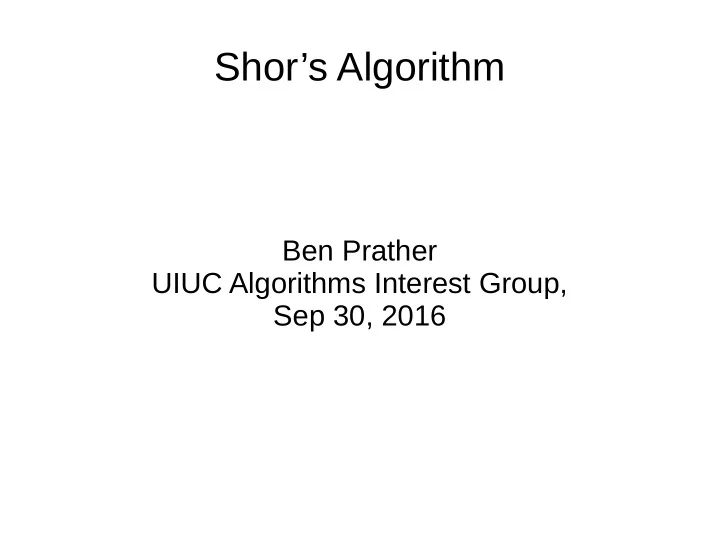

Shor’s Algorithm Ben Prather UIUC Algorithms Interest Group, Sep 30, 2016
History ● Before/invented “quantum computing” as a popular field ● CS people largely ignored the field, a few physicists (Feynman, Deutsch) considered the general problem ● But factorization is the basis for cryptography, and breaking cryptography gets attention ● Shor’s paper was published in ‘94. The DOD hosted its first conference on quantum cryptography in ‘95, and the NSA put out a call for research in ‘96. Research has accelerated since
Overview ● Broadly, Shor’s algorithm has two parts: 1. Reduce the factorization problem to finding the period of a function – a wrapper I will hereafter call the “factor-finder” 2. Efficiently find the period of integer functions via the quantum Fourier transform – the “period-finder”
Factor-finder: algorithm 1.Pick a random (relatively prime) number a < N, and find the period of , i.e. the smallest . (Using the quantum Fourier transform to be discussed) 2.Repeat until r is even and 3.Once this is true, N must at least one nontrivial factor
What? ● The integers coprime with N (that is, everything but its factors) form a finite, abelian group. ● Becuase of this, for a given member we can find the order (period) r such that ● That is, starting at a and multiplying by itself modulo N, we will eventually reach a again ● N divides (is a factor of) (a r – 1). This is a good start: find the order, and we’ve found something that shares factors with N.
Nontrivial Square Roots ● Now define (for r even) ● b must be a square root of 1 (mod N), but can’t itself be 1 (otherwise the period would have been r/2) ● Further, let’s require that b isn’t -1 mod N (the other requirement in step 3) ● Now let’s define , which obviously divides N, and can be found quickly via the Euclidean algorithm ● Provided d ≠ 1,N this is our answer
Why d ≠ 1,N ● If d = N, then N divides b-1, and thus , which we’ve said is false ● If d = 1, then by Bézout’s identity there are u,v such that N divides the equation (since ), implying , which again is false ● Thus d is a nontrivial divisor of N, and we are finished
A more constructive explanation ● When we define ● Via the Chinese remainder theorem we can then say b satisfies one of ● The first and last solutions are 1 and -1, but the middle two are some other, nontrivial solution (i.e. nontrivial square roots of 1)
Constructive solution continued ● Having required that neither (b+1) nor (b-1) is zero, we can construct ● And thereby say that at least one of b+1 or b-1 shares a nontrivial divisor with N
Note on prime-finder ● This whole thing relies on choosing a good starting number a. However, one can show (well, not me, but someone showed) that – Provided N has at least two distinct factors, and is not even – There is a greater than ½ probability of choosing the correct a, i.e. one for which r is even and . ● These are the only conditions on Shor’s algorithm as a whole
Period-finding: prepare the system ● Goal: find first ● We will need input and output registers capable of representing different numbers – i.e., q quantum bits long ● Initialize these to: ● And implement f(x) as a quantum function:
Wait, “implement f?” ● All that means is design an operator such that ● The quantum circuit for modular exponentiation is similar to the classical algorithm for exponentiation by squaring ● Exponentiation requires O(n) multiplications and squarings in the number of digits ● And the fastest reversible multiplication algorithm requires O(n log(n) log(log(n))) (Schönhage-Strassen)
Period-finding: apply the qFt ● The quantum Fourier transform is just the discrete transform applied to a superposition of states. It maps each x like: where ● Thus on our state:
Period-finding: apply the qFt ● We can reorder the sum so that the state reads Sum over range Sum over multiplicity on range Sum over (transformed) domain ● Breaking x into x 0 + rb, where x 0 is the first occurrence f(x 0 )=z, and r is the period of f:
Period-finding: interpreting the result ● Since , will be nearly some integer c ● Taking the continued fraction expansion eventually yields integers d,s such that where but . ● This is our candidate for r! We can verify s or guess similar candidates, and start over if necessary
Notes on the period-finder ● f(x) must be implemented as a quantum function, which actually takes more gates than the quantum Fourier transform itself. ● Because of this, the circuits for period-finding also change for each choice of a: choose wrong, reconfigure the computer. Luckily there’s a (1-1/8) = 87.5% chance of success after 3 iterations.
Implications ● RSA, Diffie-Hellman, and even elliptic-curve encryption algorithms assume that the factorization problem is exponentially hard – but a quantum computer would be able to recover users’ secrets (factors) from public information (products) in only polynomial time in the key length ● There has been significant work on “post-quantum” algorithms, and quantum-resistant replacements for RSA, Diffie-Hellman, hashing, etc have been put forward. But adoption is slow (there are a lot of computers to change) ● Research in quantum computing, and (post-quantum and quantum-based) cryptography has increased steadily since.
References ● Original paper (clear, worth reading): here ● Wikipedia’s explanation (notation I use): here ● Alternative, clearer explanation: here ● Scott Aaronson’s popular explanation: here
Recommend
More recommend